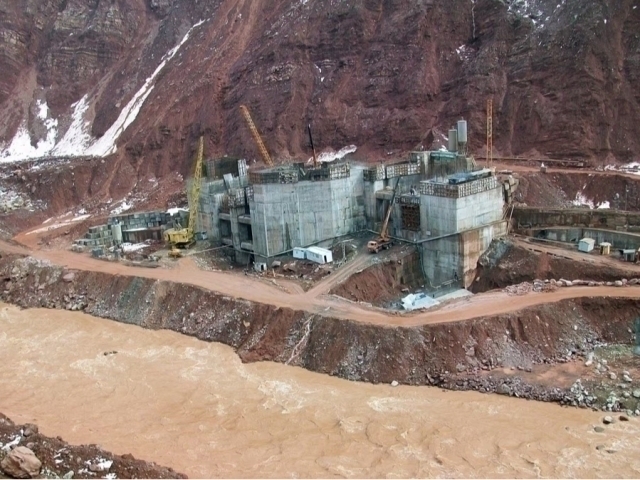Rahmon announces major progress in Rogun HPP, a project Karimov once opposed
World
−
30 December 2024 51227 5 minutes
The construction of the Rogun Hydroelectric Power Plant (HPP) in Tajikistan, which was once opposed by Uzbekistan’s First President Islam Karimov, has surpassed the 50 percent completion mark. Tajik President Emomali Rahmon shared this update during his annual address to parliament on December 28.
Rahmon highlighted the importance of the Rogun HPP, describing it as a strategically vital project for the nation’s energy security. Over the past two years, more than 9 billion somoni ($825 million) have been allocated from Tajikistan’s state budget for construction. The president expressed gratitude to international financial institutions and development partners for their continued support. He revealed that nine contracts worth approximately 10 billion somoni ($915 million) have been signed with six donors, with more than 3 billion somoni ($275 million) provided as direct assistance.
Rahmon emphasized that the next phase of financing is set for 2025, with the goal of achieving full energy independence by 2027. “Perhaps this is the last winter you will experience such difficulties. By next winter, these challenges will ease, and by 2027 they will be a thing of the past,” Rahmon assured.
Tajikistan has been financing Rogun’s construction primarily through state funds. The government plans to allocate an additional 5 billion somoni ($460 million) for the next stage. In the first nine months of this year alone, 4.3 billion somoni ($395 million) were invested. Overall, more than 40 billion somonis have been directed toward the project since construction began.
The Rogun HPP’s first two units, operating at limited capacity, were launched in 2018 and 2019. The plant will eventually house six turbines with a capacity of 600 MW each. Full completion is expected in 2029, making it the largest hydroelectric plant in Central Asia, with an installed capacity of 3,600 MW. Upon completion, the facility will generate between 13 and 17 billion kWh annually—equivalent to 65 to 85 percent of Tajikistan’s total electricity production.
$6.4 billion still required
Despite progress, the project requires an estimated $6.4 billion to reach completion by 2035, according to a report by S&P Global Ratings. The Tajik government is in talks with a consortium of international creditors to secure about 50 percent of the necessary funds. The remainder will be financed through the state budget and other resources.
S&P’s analysis notes that the initial financing package consists of $1.73 billion in semi-concessional loans, $850 million in grants, and $390 million in concessional loans. The Rogun HPP already contributes approximately 10-15 percent of Tajikistan’s electricity needs, with projected revenues from power generation estimated to reach $1.1 billion between 2024 and 2035.
While the Rogun project has been a point of contention in Central Asia, with Karimov previously voicing concerns over its potential environmental impact and water distribution, Tajikistan remains committed to completing the plant. For Rahmon, the HPP represents not only energy security but also a cornerstone for the country’s economic future.
Rogun HPP's soaring costs and safety concerns: a 15-year overview
The cost of constructing Tajikistan’s Rogun Hydroelectric Power Plant (HPP) has surged significantly since the project’s revival in 2008, reflecting the complexities and challenges of building one of the world’s tallest dams.
Initially estimated at $3 billion, the project’s price tag increased to $3.9 billion in 2016 following an international tender for the dam’s general contractor. By 2022, the Tajik Ministry of Energy projected the total cost at over $5 billion. In February 2023, the ministry revised this figure to $6.2 billion, citing updated assessments and inflationary pressures.
Construction of the Rogun HPP began in 1976 during the Soviet era but was halted after the USSR’s collapse. Following independence, Uzbekistan’s First President Islam Karimov strongly opposed the project, voicing concerns over the risks of building the world’s tallest dam—planned to reach 335 meters—in a seismically active region.
For decades, only preliminary work progressed, and in 2012, the World Bank’s inconclusive reports further delayed the project. It wasn’t until 2017 that Tajikistan fully resumed construction, with the first power unit becoming operational in November 2018. Upon completion, the plant is expected to generate more than 17 billion kWh annually with a total capacity of 3,600 MW.
Despite progress, Rogun’s construction has been marred by numerous accidents and fatalities. In 2020 alone, 15 incidents resulted in three worker deaths and 15 injuries. Over 31 accidents were recorded across various state-supervised enterprises that year, causing eight fatalities and 33 injuries.
The previous year was even deadlier, with 33 accidents leading to 20 deaths and 25 injuries. A recent accident claimed three more lives, adding to growing safety concerns surrounding the project.
While Rogun HPP is a cornerstone of Tajikistan’s energy strategy, its rising costs and safety record highlight the significant risks accompanying large-scale infrastructure development. The Tajik government continues to push forward, hoping the project will secure the nation’s energy independence by 2027.
Live
AllHindistonda poezd fillar galasini bosib ketdi
20 December





